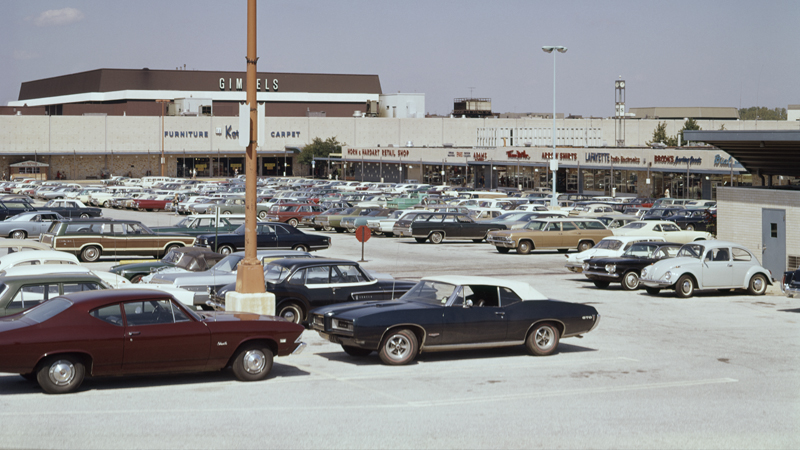
King of Prussia mall, Pennsylvania in 1970. Armstrong Roberts / ClassicStock / Getty Images
The Covid crisis has devastated U.S. retailing, with sales dropping 8 percent from February to June -- 16.4 percent in April alone. As the following article reports, shopping malls, built as meccas of U.S. retailing and mainstays of suburban life, had been suffering for a decade or more due to a “retail apocalypse” brought on by the rise of online shopping.
Now the crisis may push many over the financial edge. Many mall owners are heavily indebted and must cope with the prospect of failing tenants including anchor department stores, a number of which are on the verge of bankruptcy. The following article, written just before the COVID crisis struck, reports on trends including retrofitting malls with housing, offices and other non-retail uses—or wholesale redevelopment—that are likely to accelerate. Efforts to reinvent malls through a turn to upscale shopping and entertainment may be less viable. In any case, the crisis could be a turning point for malls in America.
In the nearly two decades since Caruso Affiliated opened The Grove, an outdoor shopping mall in Los Angeles designed to look like a Disneyland-style main street, its narrow-gauge double-decker trolley car has made thousands of round-trips from one end of the “street” to the other. When The Grove opened in 2002, the running joke in perennially congested Los Angeles was that owner Rick Caruso had finally brought mass transit to the city’s transit-starved west side.
Of course, almost no shoppers actually arrived at the Grove by public transit. Looming over the mall’s fake trolley and fake street is a very real, very large parking structure. The success of The Grove, which has thrived to the tune of over $2,000 per square foot per year, tells you almost everything you need to know about the relationship between malls and transportation.
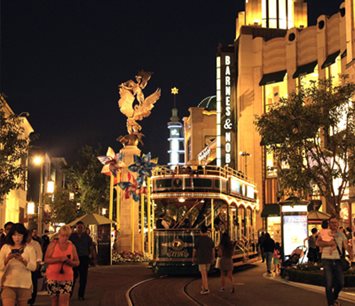
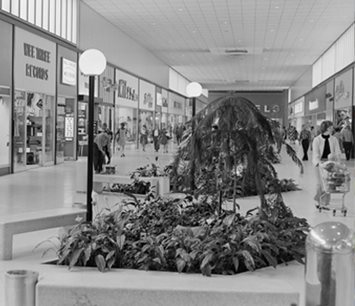 The Grove’s narrow-gauge double-decker trolley car. Prayitno / Flickr.com Pathmark shopping center, Moorestown, New Jersey in 1970. Armstrong Roberts / ClassicStock / Getty Images
The Grove’s narrow-gauge double-decker trolley car. Prayitno / Flickr.com Pathmark shopping center, Moorestown, New Jersey in 1970. Armstrong Roberts / ClassicStock / Getty Images
From the end of World War II through roughly 1990, the boom in suburban living was accompanied by an equivalent boom in suburban retail—the apotheosis of which was the enclosed shopping mall. They were built by the hundreds, often to serve towns and regions that were too new to have historic main streets, and nearly every one of them were served by parking lots that took up as much space, if not more, than the buildings themselves. In suburbs from New Jersey to California, going to the mall meant getting behind the wheel.
“If you look at the history of malls, malls were built at the periphery,” said June Williamson, chair of the architecture department at City University of New York. “The notion was that people were driving, that the old main street was ‘dangerous,' the parking was disorganized. They were seedy and not suitable for families and children. The mall was kind of a fresh start.”
Overbuilt
In the past two decades, though, the convenience of driving to a mall has faced stiff competition — from the convenience of not going anywhere at all.
Though its precise impacts are the subject of debate, online shopping has surely fueled the so-called “retail apocalypse” that began as traditional stores failed en masse during the Great Recession of the late 2000s. Even as the economy rebounded, stores—in malls and elsewhere—have suffered mightily. The U.S. Commerce Department estimates that online retail sales increased over 16 percent from the third quarter of 2018 to the third quarter of 2019—while overall retail sales increased only 4 percent.
The enclosed mall was invented in Edina, Minnesota, in 1956. The formula caught on. The number of malls in the United States grew to 300 by 1970 and reached a peak of over 1,500 in the 2000s, averaging about 850,000 square feet of interior space. Today, roughly 500 of those malls have closed or been converted to other uses, leaving about 1,000 malls with an estimated 9 percent vacancy rate nationwide.
The pattern of decline reflects, in many ways, overall patterns of urban development and decay.
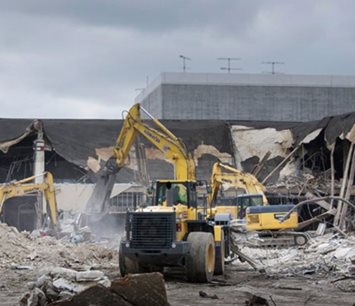
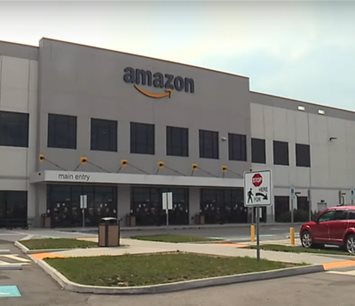 Randall Park Mall near Cleveland was billed as the biggest shopping center in the world when it was built in 1976. But it was abandoned in 2009 and demolished to make way for an Amazon Fulfillment Center. Seph Lawless
Randall Park Mall near Cleveland was billed as the biggest shopping center in the world when it was built in 1976. But it was abandoned in 2009 and demolished to make way for an Amazon Fulfillment Center. Seph Lawless
“[What was] happening with malls… was happening in suburbia, which is as the inner ring of older suburbs became more low-income, some of the malls that were there became more low-end, and some of them closed,” said Lizabeth Cohen, professor of American Studies at Harvard University.
The plague has hit malls in urban and suburban areas alike. Just a few miles west of The Grove, the once vibrant Westside Pavilion is being converted to offices for none other than Google. To the north, in the cradle of the internet economy, Santa Clara’s Vallco Mall is being demolished to make way for a mixed-use office and residential development. Many other malls, though, are experiencing no such rebirths. Their carcasses are strewn across the American landscape.
One often overlooked feature of the mall apocalypse is that, in many cases, the malls of the mid-20th century were not even designed to last into the 21st. They were built relatively cheaply on virgin land, speculating on the prospect that novelty, suburban growth, and antipathy for urban blight would attract customers. All of that came true.
As a result, many mall developers and owners profited handsomely in the early goings—and did not even plan for malls to be long-term investments.
"The profitability of building malls in suburban sites was built on a relatively short-term rate of return, then the properties would have to be reinvested in, expanded, or downgraded,” said Williamson. “From the point of view of the companies that build and the companies that operate malls, quite a bit of revenue profit was realized. They’re not failures in that sense.”
And the formula worked too well. New malls were opening even as department stores faltered and online commerce grew in the 2000s and into the early 2010s. The result is that the mall landscape is simply overbuilt. It might have been overbuilt even without online commerce. According to one study, the United States has over 24 square feet of retail space per capita (among all types of retail). Germany, where the average income is about 80 percent of what it is in the United States, has a mere 2.5 square feet.
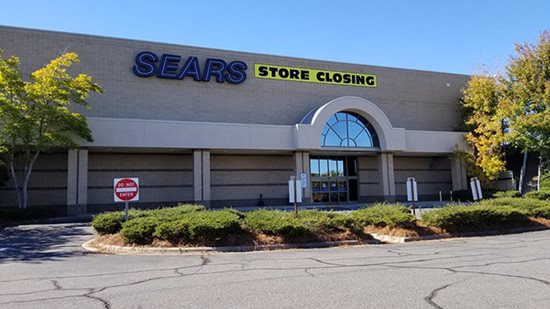
Sears at Carolina Place Mall in Pineville, North Carolina. Mike Kalasnik / Flickr.com
Mall Access
The demise of a multi-trillion dollar industry naturally has many causes. But the ability for customers and employees to actually get to their favored malls cannot be overlooked. While internet traffic has increased exponentially since the heyday of the mall, actual traffic in many places has climbed steadily as well.
Though statistics are hard to come by, the vast majority of mall visitors arrive by private car. That’s what they were designed for. Malls’ advantages will always revolve around their locations on major arteries and, often, near highways. Regional malls, as designated by the International Council of Shopping Centers, draw customers from radii between 5 and 15 miles. Super-regional malls draw customers from as far away as 25 miles.
They do not lend themselves to a casual stroll—nor even to a bus trip.
“I think if people are going to go to an actual store, they’re likely to use their car to do it, and we know that car ownership is as big as ever,” said Cohen. “A lot of people would prefer not to hassle [with traffic congestion] on the weekends. I think that’s the biggest threat.
While the average soccer mom or dad might always prefer the minivan or SUV, many employees at malls—including store clerks, maintenance staff, and the like—fit the profiles of typical public transit riders. Their satisfaction may be reason enough for malls to forge partnerships with transit agencies.
“We never built mass transit ... to move people around in suburbia,” said Cohen.“It would behoove [malls] to support the expansion of public transit and to think about this issue of access through transportation."
Prime Real Estate
“A lot of the mall real estate that exists is generally pretty good,” said Kavett. “It's generally there for a reason. Typically existing malls have good [road] access or were built around strong infrastructural pathways."
The key for many malls—and for cities and counties that don’t want unsightly dead spaces on their hands—is to repurpose themselves by capitalizing on their space and locations. And all of those acres of parking can become assets rather than liabilities.
In some cases, malls are adding housing in place of excess parking. In other cases, malls are being entirely transformed into offices, warehouses, and even schools and libraries. A few have been turned into industrial facilities.
“The need for affordable housing is acute,” said Williamson. “[Apartments are] needed in suburbs too, where you have people living longer and there's downsizing and they want to stay in their communities.”
This is the process that Ellen Dunham-Jones and June Williamson called “retrofitting suburbia” in their 2008 book of the same name. They identified over 100 malls that are in some stage of the retrofitting process.
Williamson suggested that dead malls might be ideal locations for medical and assisted living facilities, especially as suburban populations get older and have trouble navigating their houses.
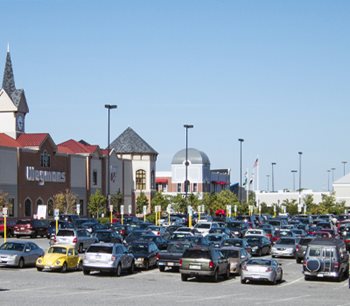
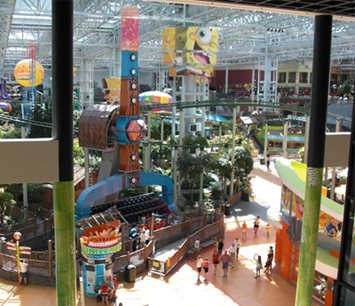 The expansive mall parking lots can be real estate assets for building houses, offices and other uses; Mall of America, Bloomington, Minnesota. aine / Flickr.com
The expansive mall parking lots can be real estate assets for building houses, offices and other uses; Mall of America, Bloomington, Minnesota. aine / Flickr.com
Sustaining Malls
Of course, this story has an up escalator as well as a down escalator. Not all malls are falling.
Malls that still want to make a go of it must, in many cases, either upgrade themselves or completely reinvent themselves. Kavett suggested that malls can no longer rely on shopping and conspicuous consumption, especially since so much of it has moved online. Ephemera like dining—beyond food court Sbarros and Chick-fil-A's—and entertainment are just as important, if not more so, than traditional department stores and retail chains.
“These spaces need to be something more than just shopping,” said Kavett. “If malls are well situated and easy to get in and out of and fun, they don’t necessarily need to keep everyone locked in there and leaving with eight shopping bags.”
Many new malls are being designed along the highly successful model of The Grove—as simulacra of traditional urban streets and town squares, often called “lifestyle centers." In that sense, malls have come full circle to resemble the urban form that they were built to replace. In many cases, malls are blamed for eviscerating main streets and small retailers by drawing customers away from traditional town centers.
This style is an odd variation on a broader social trend in which Americans—especially young adults—are embracing and rediscovering city life and rejecting the commercialization and homogeneity of the suburbs.
“They’re recognizing the same thing that we’ve learned about downtowns: the modernist Corbusian-inspired concept of separating residence and work and play—including consumption—is not a winning strategy,” said Cohen, referring to Le Corbusier, the pioneering, and controversial, modern architect and planner.
Generally, upgraded malls appeal to upscale customers. While lower income customers might go to Walmart and Target, higher income customers go to Nordstrom and Tiffany's. Malls that once relied on Sears, Chico’s and RadioShack are the ones getting squeezed out.
Williamson noted that malls that choose the quasi-public model should in fact try to be as public as possible.
“The more those types of projects actually are mixed use—and not just appear as if they might be mixed use—the better,” said Williamson. “It can engender a desire and insistence that those spaces really are public, especially if any public money has gone into subsidizing the retrofit or redevelopment.”
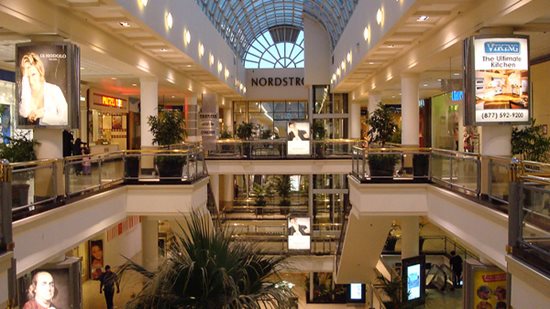
Westside Pavilion Mall, Los Angeles, California. Eric Fresh / Flickr.com
Embracing Malls
Critics often mock new malls and “lifestyle centers” for being inauthentic or Disney-esque—witness The Grove’s novelty trolley. Williamson dismisses those criticisms.
“The benefits of retrofitting can be better realized so people can drive less, can do different kinds of daily errands without causing more congestion. It can build more social connections…and reuse property that’s already been urbanized and developed rather than building anew out in the periphery,” said Williamson. “These are all benefits, regardless of whether we consider the design cheesy or inauthentic.”
One question surrounding the death of malls is whether anyone should care. From the perspective of transportation, more online shopping can mean marginally fewer cars on the road. Fewer malls can also mean more shoppers for Main Street. But it also means that cities fail to reap sales tax revenue, and suburbanites lose a traditional gathering space, however corporatized it may be. A sizable mall can generate up to 30 percent of a municipality’s annual tax revenue. (By contrast, Walmart is known for tough negotiating tactics that often put localities in the red in exchange for often dubious “economic development” benefits.)
For that reason, many local governments have incentive to hang on to their malls.
“Malls, as with all retail, have the ability to make money for a municipality,” said Kavett. "If they fit in with the community and make the community happy, I think there’s an obvious partnership.” ♦
Josh Stephens is a freelance writer based in Los Angeles.